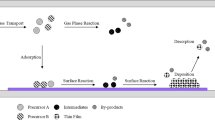Abstract
The RCA Standard Clean, developed by W. Kern and D. Puotinen in 1965 and disclosed in 1970 [1] is extremely effective at removing contamination from silicon surfaces and is the defacto industry standard.[2]. The RCA clean consists of two sequential steps: the Standard Clean 1 (SC-1) followed by the Standard Clean 2 (SC-2). The SC-1 solution, consisting of a mixture of ammonium-hydroxide, hydrogen-peroxide, and water, is the most efficient particle removing agent found to date. This mixture is also referred to as the Ammonium- Hydroxide/Hydrogen-Peroxide Mixture (APM). In the past, SC-1 solutions had the tendency to deposit metals on the surface of the wafers, and consequently treatment with the SC-2 mixture was necessary to remove metals. Ultra-clean chemicals minimize the need for SC-2 processing. SC-1 solutions facilitate particle removal by etching the wafer underneath the particles; thereby loosening the particles, so that mechanical forces can readily remove the particles from the wafer surface. The ammonium hydroxide in the solution steadily etches silicon dioxide at the boundary between the oxide and the aqueous solution (i.e., the wafer surface). The hydrogen peroxide in SC-1 serves to protect the surface from attack by OH− by re-growing a protective oxide directly on the silicon surface (i.e., at the silicon/oxide interface). If sufficient hydrogen peroxide is not present in the solution, the silicon will be aniostropically etched and surface roughening will quickly occur. On the other hand, hydrogen peroxide readily dissociates and forms water and oxygen. If the concentration of the resulting oxygen is too high, bubbles will appear in the solution. The gas liquid interfaces that result from the bubble formation act as a “getter” for particles that can re-deposit on the wafer surface if a bubble comes in contact with the wafer.
Similar content being viewed by others
References
Kern and D. Puotinen, RCA Rev. 31, 187 (1970).
Kern, J. Electrochem. Soc. 137, 1887 (1990).
Verhaverbeke S., J. W. Parker, and C. F. McConnell, “A Quantitaive Model for SC-I Processing,” UCPSS '96, ACCO, Leuven, Belgium, 1996, p. 153.
Perrin D.D., “Ionisation Constants of Inorganic Acids and Gases in Aqueous Solutions, ” IUPAC Chemical Data Series No. 29., Pergamon Press, N.Y., 1982.
Rigo: “Silica films on Silicon,” in Instabilities in Silicon Devices, Volume 1, (Edt.G. Barbottin an A. Vapaille, North Holland, 1986) p. 57.
Graef D. et al., ASSIST Progress Report 2, Espirit Basic Research Action 6108 (European Union, Brussels, 1995)
Verhaverbeke S., J. Parker and C.F. McConnell, Quantitative Model for the SC-I Cleaning, ECS Fall 1995, Chicago, ECS Fall Proceedings.
Ryuta I Takabashi, C. Okada, H. Koabayashi, G. Maeda, and T. Shingyouji, The Electrochemical Society, 95–2, 688 (1995).
Sakurai, J. Ryuta, E. Morita, K. Tanaka, T. Yoshimi and Y. Shimanuki, ECS, 471, 710 (1990).
M. Morita, T. Ohmi, E. Hasegawa and A. Teramoto, J. Apl Physics, 29., (12), L2392–2394, (1990).
T. Ohmi, T. Isagawa, M. Kogure and T. Imaoka, J. Electrochem. Soc., 140, (3), 804, (1993).
N. Nakamura, T. Futatsuki, K. Makihara and T. Ohmi (ECS Proc. 9407 Pennington, NJ, 1994), p. 70.
H. Kawahara, K. Yoneda, I. Murozono and T. Todokoro (IEICE Trans. Electron., E77–C, (3),1994), p. 492–497.
Stoneham A.M. and P.W. Tasker, Image Charges and their Influence on the Growth and the Nature of Thin Oxide Films, Philosophical Magazine B, 55, No. 2, 237–252, (1987).
Author information
Authors and Affiliations
Rights and permissions
About this article
Cite this article
Verhaverbeke, S., Parker, J.W. & McConnell, C.F. The Role of HO2− in SC-1 Cleaning Solutions. MRS Online Proceedings Library 477, 47–56 (1997). https://doi.org/10.1557/PROC-477-47
Published:
Issue Date:
DOI: https://doi.org/10.1557/PROC-477-47




